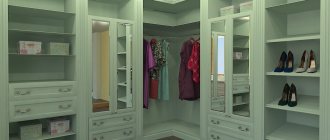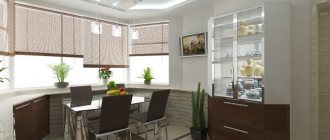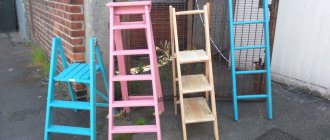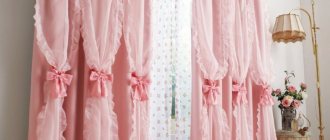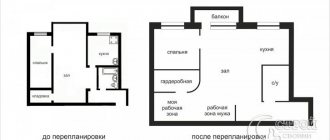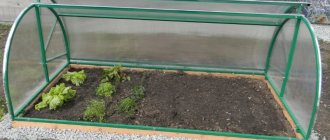129214
A wardrobe is an important room in a house or apartment. You can put winter, spring, autumn outerwear and shoes in it. The presence of this corner will allow you to rationally calculate the entire space of your home and remove bulky items that often take up most of the space in closets. But first you need to correctly calculate the size of the dressing room and it is advisable to do this at the design stage, but this is not always possible. If this room is not provided, then you can arrange it yourself.
Types of dressing rooms
Before you understand how to plan a dressing room, you need to know what types of storage systems there are.
Frame storage system
These are racks spaced between the floor and ceiling, on which drawers and shelves are located.
The advantage of such a storage system is the variety of contents.
Mesh storage system
The design is similar to the frame system, only the modules are mesh drawers and shelves.
Advantages: compactness and constant air flow to things.
Panel storage system
Its basis is made up of horizontal panels to which drawers and rails are attached.
This designer allows you to assemble a dressing room to suit any request.
Design project by Molteni&C
Where to install a dressing room
Bedroom
This location is logical and justified. Here the choice of clothes and their change take place.
To separate the sleeping area and the dressing room, swing or sliding doors, a screen or curtains are used.
Hallway
It is unlikely that it will be possible to turn this room into a full-fledged dressing room; rather, it will be two rows of cabinets located opposite each other.
Passage area between rooms
Ideally between the bathroom and bedroom. In this case, it is worth taking care of forced ventilation to avoid increased humidity.
Organizing a dressing room: types of layouts
The layout directly depends on the size of the room, the location of windows and doors.
Linear
Similar to a wardrobe, but without doors or divisions into zones.
It is used for a long room, it is optimally located - along a blank wall, but is also allowed near the doorway.
Parallel
Organizing a dressing room in a parallel way is the best choice for long and narrow rooms.
There are hangers and shelves on the sides, and a large mirror opposite the entrance.
U-shaped
The most convenient option for large rooms with one wall more than 1.5 meters.
Shelving and racks are located along three walls of the room, which ideally should be rectangular or square.
L-shaped
Adjacent walls form a corner, opposite there is an entrance and an additional, unused wall.
This arrangement implies the placement of additional furniture.
Corner
The optimal choice for bedrooms and rooms with a small area.
The entire storage system is placed along adjacent walls, and the third side is made in the form of a screen or sliding doors (behind which there may be a bed).
Design and selection of furniture
The design of the dressing room must certainly be in harmony with the interior of the room it is adjacent to. For example, wooden shelves are best suited for a classic style, and plastic and metal for a modern high-tech style.
How to place a corner dressing room in the bedroom, types of designs
There are several tricks for placing such furniture in a small room:
- For a very small dressing room, you can adapt a niche in the wall, the passage to which is covered with curtains or sliding doors.
- If the room is very cramped, the dressing room should be left open, but with a large number of roll-out drawers, shelves, and hangers. An ottoman and a mirror will successfully complement such an interior.
In a small bedroom, racks with casual clothes can be placed behind the headboard.
Furniture designs for dressing rooms are varied, but must be ergonomic and functional, these are:
- tall cabinets without doors;
- racks of different sizes that have a specific purpose: storing shoes, clothes or accessories;
- drawers for underwear or with crossbars for trousers;
- systems for storing raincoats, down jackets, coats, dresses, jackets;
- shelves for storing winter, summer and demi-season shoes;
- vertical spiral hangers for bags and clutches.
For small walk-in closets, modular furniture made of metal is suitable. Also, a mobile structure designed to accommodate various hangers will take up little space in the room. Shoes are placed under it, and hooks for bags are mounted on the sides.
Drawers
Tall cabinets without doors
Shoe storage shelves
Outerwear storage system
Shelving
Spiral hanger
Choosing the size for the dressing room and cabinets in it
The best shape for a dressing room is a rectangle. Its minimum area should be 3 sq.m, and the length of one of the walls should be at least 2 m.
To calculate the length of the dressing room, the formula is used - the desired number of compartments multiplied by their width (50.75 or 100 cm).
To determine the width, it is necessary to take into account not only the depth of the cabinets (50-60 cm), but also the place for opening them (pulling out drawers).
The width of the passage can vary from 50 to 100 cm.
Recommendations for dressing room sizes:
- There should be a distance of 2 to 5 cm between the hangers and the cabinets; their width depends on the size of the clothing and varies from 34 to 51 cm.
- Length from the bar to the bottom shelf: 1.5 m for long clothes and 1 m for short ones.
- The distance from the rod to the top shelf is 5 cm, between two rods – 100 cm.
- The height of the trouser compartment is 1.2-1.3 m.
- The distance between the shelves is 35-40 cm, depth – 40 cm, width – 50-60 cm.
- Dimensions of storage boxes: height – 40 cm, width – 40-70 cm
- For a person of average height, drawers should not be located higher than 140 cm, preferably 110 cm.
Internal filling
The filling of a dressing room can be quite varied. Closed (with different door designs) and open systems are used. The most popular devices are:
- Hanging rods on which dresses, shirts, coats and other things hang, as well as trouser pull-out lifts. In the women's section it is necessary to provide space for maxi dresses, the height of which varies up to 165 cm, while in the men's section 100 cm is sufficient.
- Drawers are designed for storing bedding and underwear, as well as other accessories. In the men's dressing room there should be space for ties.
- Shelves are used in two versions - stationary and roll-out.
- A pantograph as a modification of a barbell is convenient because of its mechanism, which allows you to make it lower and get the required things.
The sizes of men's and women's shoes may differ in length and height: for example, winter over-the-knee boots may not fit into a regular compartment; they require separate containers or special shelves.
To plan the optimal filling taking into account the size of the room, you need to divide it into several functional zones:
- First, choose a place to store long clothes; later, short items will be much easier to distribute throughout the dressing room;
- place hats on top and shoes on bottom;
- things that are used every day should be placed at eye level, while everything else (suitcases, pillows, etc.) should preferably be placed on the mezzanine.
Advantages and disadvantages of metal wardrobe cabinets
A mirror is an important component of every apartment. Its location can be provided in any room of the house with a dressing room. In a bedroom with an open corner type, it is recommended to attach the mirror on the nearest wall, but if it is a special room - on the door or on a separate facade with a mirror surface.
What to place in the dressing room
Dressing room equipment includes:
- Cabinets, pantographs and rods. This is where the design of the entire storage system begins. Shirts, jackets, blouses and dresses will be placed here. The pantograph will allow you to place several rods on top of each other and provide free access to every item.
- Pull-out trouser hangers.
- Drawers. Their purpose is to store bed linen, underwear and accessories. Larger drawers will require dividers.
- Shelves. Stationary or retractable.
- Compartment for ironing board, iron, steam generator and dryer.
- Full length mirror.
- Ottoman or console.
- Boxes and baskets. You can store not only shoes in them, but also magazines, sewing supplies, and out-of-season accessories.
Wardrobe from Gianni Borgonovo
Article about furniture
Author - designer of the company DEZALT Sukhanov Eduard
If you have a small dressing room, you need to properly plan the space for clothes. I’ll try to tell you how best to arrange a small dressing room.
Let's take as a basis a rectangular room measuring 1700 by 1000 millimeters, which is most often found in apartments.
Let's start with clothes rails. If you need to store mainly short clothes, then you can place two rods with a length of 1000 mm. on top of each other. The height from floor to ceiling is usually from 2450mm. and higher, let's take 2600mm as a basis.
This means we subtract the thickness of the tubes (25mm x 2 pieces) and the gap from the ceiling to the first tube (50mm), we are left with 1250mm. under each bar.
A medium-length jacket will easily fit into this size, and you don’t have to worry about jackets and blouses at all. Of course, a coat, fur coat, raincoat will not fit; they require a height of 1500mm.
Let’s assume you are satisfied with this option and are not afraid that you will have to reach for the top row of clothes with a special fork or stand on something to reach the hanger with your hand.
Then along the long side of the wall, you need to make a row of shelves and several drawers.
It’s not worth making shelves on both sides in such a tight space. Even if you only take 300mm from each side. under the shelves, you will have a passage of 400mm. It will be extremely inconvenient for you to squeeze between the rows, and you won’t be able to place things normally on such defective shelves.
It’s better to make shelves and drawers on one side, plan the depth at 400mm, well, you can do 500mm, but then you will be cramped. If you need drawers (we are talking about the full extension function), with a shelf depth of 500mm. they will rest against the opposite wall when pulled out, but if they are 400 deep, like all the shelves, you will have a gap of 100mm. for normal opening and closing of the drawer. It will be a little more convenient for you to use.
Suppose the option with rods for short clothes is not suitable for you, you have things below the knee length and they also need to be stored somewhere. Then I propose to make the top bar for clothes 1000mm. and raise the lower one from the floor by 1500mm.
Thus, from below you can hang anything, coats, raincoats, dresses, fur coats, and they will not touch the floor. At the top you will have room for short items such as jackets, folded trousers, blouses, etc.
Let's assume that one meter long rod is enough for you. Then we make a barbell from the floor at a distance of 1800mm. from the floor, and on top we add a shelf for storing things with a height of 293 mm. 400mm remains. from above, under the mezzanine shelf. It is advisable to make the mezzanine shelf united with the section that will go along the long side of the dressing room.
We can make a shelf under the bar at a height of 284 mm, or you can not make this shelf, but leave empty space for household items. For example, you can push in a vacuum cleaner or store something bulky in boxes. You can put a suitcase for travel.
Sometimes, in order to save two rods, but not reach for the top one, you can place a pantograph under the ceiling. It was specially invented for convenience. You pull the handle, the bar lowers on gas elevators. He took the clothes he needed, or hung them up, let them go, and he himself went up.
But unfortunately, it is almost never used in small dressing rooms, because when lowered, it needs space.
Go ahead. You have so many hanging items that two meter-long rods are not enough. Then you can make shelves in the dead end of the room instead of rods, and run rods along the long wall on two floors. Of course, it will be a little inconvenient for you to move along the clothes on hangers, because there will be literally 450mm of space left. for the body, 550mm. clothes will be taken away. But you can fit a whole mountain of clothes on hangers.
If two levels of rods are not required, a row of rods can be made at a height of 2109 mm. from the floor, and model shelves and even drawers below. It turns out that below you can store shoes, folded things, small items in drawers, and on top you will have a barbell. But that's not all. You can make a mezzanine above the bar and combine it with a shelf at the dead end of the room.
But there is another option on how to arrange a small dressing room. Pay attention to the metal structures of the “Elf” type. These are stacked shelves, mesh drawers and rods that are attached to vertical rails. The beauty of them is that you can combine the arrangement of shelves and rods if you realize that the original option is inconvenient. The disadvantage is that the price unfortunately goes through the roof for this system. Sometimes it’s cheaper to order the same thing from us. There is a similar system in “Ikea”, cheaper, but the quality is worse than “Elves”, thin metal.
Of course, you need to consider the location of the entrance to the dressing room.
It happens that the entrance is located in the center of a long wall, and sometimes even from the corner of the room. In this case, you can try placing shelves and rods around the perimeter of the room.
Very often, we are asked to make a mezzanine shelf, both in dressing rooms and in wardrobes. This is convenient when you can put something rarely used at the very top, such as a travel suitcase or an artificial Christmas tree. So don't neglect this opportunity.
A big problem in small rooms is the corners. Most often they have rods, less often shelves. If shelves are made without vertical posts, with an open corner, they are fragile. You can’t put something heavy on them, and leaning on them too much is dangerous, they’ll break off.
In dressing rooms you can make drawers with closers, because there is no need to wait until it closes, so as not to get pinched by the compartment door. But in wardrobes, the door closer usually starts to irritate.
Let me remind you what you can store in your closet: stepladder, vacuum cleaner, steamer, ironing board, large boxes, travel suitcases.
Based on my advice, try to draw a plan for your future dressing room.
Don't forget about the dimensions!
How far and in which direction will the drawer extend?
How will you pass, will you have enough space?
Mezzanine shelves can block your lighting.
Where will the pantograph go down?
Wouldn't an interior door close off the space in your dressing room?
Do you have enough space to use the corner of the dressing room?
In cramped dressing rooms, it is worth abandoning strongly protruding handles.
And don't forget to think about the hood. Of course, this is not critical, but in general, if the air does not circulate, an unpleasant musty smell may appear. It happens that some thing that you store emits an unpleasant odor, for example, rubber boots for fishing, a plastic casing from some kind of device. Rest assured, all your clothes will be saturated with this smell. It’s just that many people don’t attach importance to this, but in vain.
In conclusion, you can evaluate our work on arranging compact wardrobes. See drawings and videos below.
Dressing room in Zhukovsky.
Dressing room in Korolev.
Dressing room Moscow.
Dressing room in Mytishchi.
Dressing room Moscow.
Lighting in the dressing room
The dressing room lighting must meet two requirements: accurately convey shades and provide good illumination, but not blind the owner.
To fulfill the first condition, it is better to choose lamps with a neutral or warm shade.
For the second, it is necessary to provide for changes in the direction of the light rays.
Most of the sources should be concentrated around the mirror: directly above it and on the sides 8-10 cm below eye level.
Spotlights
Spotlights are used for central lighting and to illuminate individual areas.
LED bulbs
Due to the lack of heating, they do not damage the fabric and do not increase the temperature in a small room.
Can also create an interesting accent
Chandeliers and wall lights
This is the choice for a spacious dressing room, but even in this case, you should give preference to chandeliers without pendants.
Closet Layout Ideas
In order for a room to fully perform its assigned functions, it is necessary to properly organize its layout.
Functional island
A chest of drawers or a display case placed in the middle of the room will not only tie the style of the room together, but will also serve as a place to store accessories, ties, jewelry and other small items.
To improve ergonomics, you should give preference to oval chests of drawers equipped with backlit countertops and plinths.
Seating area in the center of the dressing room
This could be a sofa or pouf in the middle.
This seating area is a good choice for a large dressing room intended for the whole family.
Nearby you can place shoe shelves or a chest of drawers for accessories.
Illuminated niches
This solution when organizing a dressing room will allow you to fully utilize every corner of the room and create additional space for storing shoes and bags.
Illuminating the shelves will visually enlarge the dressing room and give it volume.
Storage Dimensions
An important criterion when arranging a dressing room is the correct calculation of places for storing things. It is important that the systems do not occupy a large area, but at the same time accommodate a lot of clothes. Every thing should be in its place and at hand.
For clothes on hangers
Typically, most of the dressing room is occupied by the area with hangers. This area is intended for hanging coats, jackets, down jackets, and fur coats. Also in this area should be placed hangers with trousers, dresses, skirts and other items that are intended to be hung on hangers.
In order to correctly calculate the size of the area for hangers, you need to pay attention to the following important criteria:
- the dimensions of the hangers, which are intended for an adult, are approximately 45 cm;
- for hanging a shirt, the distance from the floor to the bar should be 100 cm, for a suit - 140 cm, for a long dress - 180 cm;
- each hanger with clothes will require at least 7 cm;
- To save space, you can use elevator-type mechanisms or lifting rods.
Shelves
Storage systems must have shelves. On the shelves you can store various bed linens, blankets, rugs and other bulky items. Shelves can be stationary or retractable.
If the shelves are deep, then they should move forward. This requirement allows you to access things that are stacked closer to the wall. To prevent the contents from falling out, it is desirable that they have a limit.
A few recommendations for a dressing room with shelf sizes:
- for beds, towels and other bulky items it is worth using shelves with the maximum width;
- for small items and accessories - hats, bags, small shelves with a height of 15-17 cm and a depth of 25 cm are suitable;
- When choosing shelves, you should consider how much space the folded items will take up. Typically this figure is 25-30 cm.
For shoes
You can store different types of shoes in your wardrobe - winter, summer, autumn, spring. The shoe storage area should be arranged according to the following characteristic qualities of shoes:
- the average length of men's boots size 43 is 28-30 cm;
- The width of men's shoes is 25 cm;
- the standard height of women's and men's boots is not higher than 15 cm, high-top winter boots can be 25 cm in height;
- The height size of women's boots can be from 45 to 60 cm;
- shoes with heels in depth can take from 29 to 34 cm, width from 19 to 26 cm, height from 16 to 21 cm;
- shoes with flat soles can be from 29 to 34 cm in depth, width from 19 to 26 cm, height from 16 to 21 cm;
- high shoes - depth from 31 to 36 cm, width from 21 cm to 31 cm, height from 26 to 36 cm.
You can store shoes in boxes, on open shelves, on special stands, or in a suspended state. Shoe racks with a retractable design are considered a good option. They are quite roomy and do not take up much space.
Drawers
Drawers with a sliding mechanism are considered convenient and spacious. To make them slide out easily, I install special mechanisms on these products. Due to this, you can easily push the structure into place, without applying much effort.
The inside of the boxes can be divided by partitions into several segments. This allows you to put a certain type of clothing and things in each compartment, preventing mixing.
Drawers are produced in different sizes. Large boxes are convenient for storing linen and bedding. In smaller drawers you can store small things and various small accessories.
Honeycomb baskets
Cellular baskets are considered convenient places for storing various things - outerwear, bed linen, blankets, pillows, and so on. The baskets are attached to the wall using special guides and brackets. They occupy a small area, have good capacity and versatility.
Due to the fact that these products have a lattice design, the laundry stored in them is constantly ventilated and is not affected by mold. In addition to baskets, honeycomb shelves, rods, trouser racks, and shoe shelves are produced.
Dimensions of honeycomb baskets:
- width varies from 25 to 90 cm;
- depth from 8 to 28 cm;
- the size of each cell can be from 2 mm to 2 cm.
Special accessories
In addition to shelves, drawers, hangers, baskets and other important components for storing things, it is necessary to provide important accessories for storing small items. Accessories include the following:
- devices for hanging trousers, trousers, skirts;
- special holders for ties and belts;
- hooks for umbrellas, bags;
- stands for hats, caps, various headdresses.
Planning a small closet
How to design a small dressing room and is it even possible? Yes.
A modest-sized storage room can be functional and convenient if the following recommendations are taken into account when creating it:
- There is no full-fledged closet; it has been replaced with shelves, drawers and miniature cabinets mounted on the wall.
- Most of the furniture has transparent doors to make it easier to find things.
- A full-length mirror is a must. It visually expands the space.
- The project is based solely on the individual characteristics of the owner. A small dressing room should not have shelves “in reserve”.
- The basis of the project is a rod placed in the center. It is complemented by drawers, shelves and baskets.
- The smaller the area, the more actively special storage systems are used.
- If the size is very modest, place only clothes of the current season in the dressing room, store all other things on mezzanines or top drawers of cabinets.
- To decorate the walls and floor, use monochromatic neutral colors that visually expand the space: white, light gray, beige, pale blue.
- Actively use multi-level lighting, giving preference to compact LED lamps.
Corner placement is the best choice for a mini-wardrobe. This storage system will fit even into the bedroom.
You can visually zone a room and create additional niches using plasterboard structures.
U-shaped layout is the choice for a room (storage) whose area does not exceed 2 sq.m.
When placing racks and shelves, it is necessary to provide free access to the end wall.
Design project: Andrey Gordinsky
How to organize storage in a dressing room?
Daria Mikhailova: When planning any space, first soberly assess your needs and decide which ones are priority. In the dressing room we need a well-thought-out system of rods, drawers and open shelves for different types of clothing. And most importantly, you should like the result of your work. Therefore, do not forget about pleasant little things: fresh wallpaper or paint inside the dressing room, a rug or a large mirror, if space allows.
Open shelving
Make life easier by turning one wall of your closet into open shelving. This will make it easier to find your folded clothes in the morning, and you'll have room for boxes of things like laundry, for example.
Organization by levels
It is better to make storage systems inside the dressing room right up to the ceiling, especially if there is not a lot of space in the room. Upstairs can be used to store seasonal clothes and shoes, summer and winter blankets, small suitcases and other items you don't use often. Below, place a railing from which it is convenient to take frequently used clothes. Sort it by color to make it easier to find what you need. Under the railing, place drawers for things that you don’t want to keep in sight - they will balance open storage.
Storing small items and bags
It is better to store linen in drawers. To prevent the search for the right thing from turning into torture, you can buy practical and beautiful laundry organizers. Socks, tights, and knee socks can be placed in pull-out baskets.
For bags you need to provide one or more shelves: the hanging option is only suitable for textile bags and those that are used quite often (otherwise they will gather dust). Leather ones will quickly lose their shape and the handles will stretch, especially if the bag is heavy.
